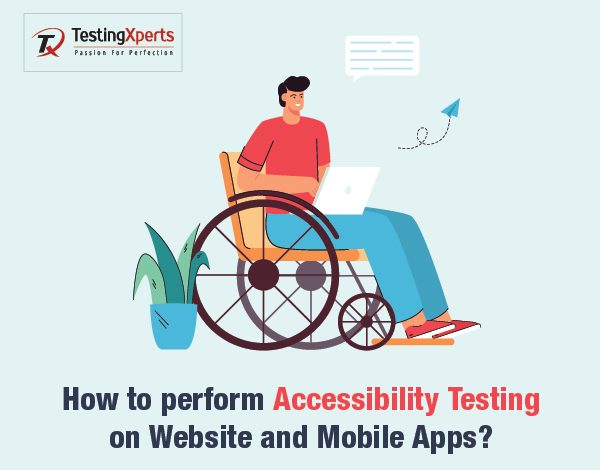How to perform Accessibility Testing on Website and Mobile Apps?

Organizations are focused on developing the website and mobile applications that are fully accessible, thereby covering the disabled community, which constitutes approximately 15% of the world’s population as per a research report. Company owners must make it a point to develop the application based on WCAG (Web Content Accessibility Guidelines) standards.
Only then can a website be referred to as a fully accessible website. In this article, you will get to know the steps required to perform accessibility testing on the website and mobile apps.
What is Website Accessibility Testing?
It is a testing method that verifies whether disabled users can use and navigate through the digital content displayed on the website or not. It ensures that the website content is fully accessible to disabled people. Accessibility testing tools are leveraged by QA teams for their testing needs like a screen reader, speech recognition etc. When accessibility testing is implemented in the testing process, website content can be easily accessible to all users without any issues. This testing method is also considered to be a subset of usability testing.
Following are the five steps required to perform web accessibility testing:
- Initiate with a well-defined plan for carrying out the testing process: In this step, there are nine key points that should be taken into consideration as displayed below:
1.1: The scope of the tests, strategies, risks and objectives should be ascertained
1.2: Ascertain the specific resources of the essential tests
1.3: The testing strategies should be implemented
1.4: Develop a schedule for designing and analyzing the tests
1.5: The tests exit criteria should be ascertained
1.6: The results should be analyzed and measured
1.7: The progress should be monitored and documented
1.8: Corrective actions should be initiated
1.9: A testable DoD (Definition of Done) should be defined for each accessibility requirement in the product backlog.
- Analyzing and designing the tests: In this step, there are twelve key points that should be taken into consideration as displayed below:
2.1: Evaluate the evidence base
2.2: Test objectives, test data required, test requirements and test conditions should be identified and prioritized
2.3: The testability requirements and the system should be evaluated
2.4: Particular combinations of test data, actions and expected results are designed so that major quality risks can be appropriately covered
2.5: The test data that is required for the test cases and conditions should be identified
2.6: The test environment should be designed
2.7: Infrastructure and specific tools should be identified by the team
2.8: Accessibility evaluation tools should be selected
2.9: CSS and HTML checkers should be selected
2.10: Simulators should be selected for various types of visual disabilities
2.11: Assistive technologies should be selected
2.12: Simulation aids should be selected for the purpose of testing.
- Implementing and executing tests: In this step, there are twelve key points that should be taken into consideration as displayed below:
3.1: Test cases should be developed, implemented and prioritized. Test data should be created and test procedures should be written
3.2: Test harnesses should be prepared and automated test scripts need to be written
3.3: The sequences and test sets of test procedures should be organized for the efficient execution of tests. The various constraints should be taken into consideration so that the tests can be performed in a specific order
3.4: The test environment should be verified to know whether it has been installed successfully or not
3.5: Both automated and manual test cases should run
3.6: Test results should be recorded
3.7: The expected and actual results should be compared. The identification of anomalies may be required where the expected and actual results do not match
3.8: The anomalies that are being investigated may result in the analysis of incidents and the creation of reports
3.9: The corrected or updated tests should be repeated
3.10: When the new test versions arrive, run regression tests
3.11: The design architecture should be reviewed. Interfaces and software components should also be reviewed for traceability with accessibility requirements
3.12: An accessibility checklist should be used.
- Assessing reporting and Exit criteria: In this step, there are four key points that should be taken into consideration as displayed below:
4.1: The test records should be checked against the tests exit criteria specified during test planning
4.2: Analyze whether there is a need for further testing or modifying the specified exit criteria
4.3: A test summary report should be written for business stakeholders
4.4: Scrutinize whether there is a need for further accessibility testing.
- Test closure activities: In this step, there are five key points that should be taken into consideration as displayed below:
5.1: Confirm test deliverables
5.2: The test infrastructure, test environment and testware should be finalized and archived for later use during maintenance
5.3: The testware should be delivered to the maintenance organization
5.4: A retrospective study should be conducted, so that projects, testing processes and future versions can be taken into consideration for further improvements
5.5: Finally, the accessibility testing assets should be stored in the software configuration repository.
Read more: https://www.articledaisy.com/how-to-select-a-professional-qa-software-testing-company
Following are the two ways to perform accessibility testing for mobile apps:
- TalkBack: It is Android’s built-in screen reader. When TalkBack is on, users need not see the screen while interacting with their Android device. This application is great for people with vision impairments who find it difficult to navigate mobile-based websites.
Here are a few points that need to be taken into consideration while testing:
- All of the elements should be properly labeled, so that user can easily listen to what TalkBack is reading
- The popup windows or notifications should be read to the user
- The page should be easily swiped by the users to explore and navigate every page element
- The double-tap feature should be easily accessible to users so that the application should be randomly explored or specific elements should be picked to explore
- Switch Access: This application helps users to interact with Android devices not by using the touch screen, but, rather by using a switch.
Following are a few points that need to be taken into consideration while testing:
- The application should be easily navigable to the users
- The content should be added and edited easily when there is specific text or other inputs involved
- The highlighting of an item should happen when an action is performed with them
- The available functionality through custom actions and selectable controls should be ascertained
- The spoken feedback for each element should be able to convey its purpose or content appropriately.
Conclusion: If you are looking forward to implementing accessibility testing for your specific project, then do get connected with a highly acclaimed software testing services company that will provide you with an effective testing approach that can justify your project specific requirements.




